Alec Baldwin shooting incident calls into question the legacy of the Western
The tragedy on the set of ‘Rust,’ in which cinematographer Halyna Hutchins was killed by an accidental gunshot, has opened debate about security in the movie industry and gun culture in the United States
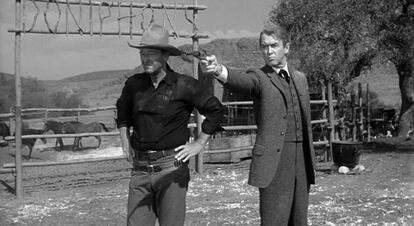

Moments before his life was changed forever, US actor Alec Baldwin was showing the cameras how to draw a revolver. After the actor’s movement, a “whiplash” and a “loud bang” were heard on the set, according to a witness statement. Following the gunshot, Halyna Hutchins, the director of photography on the independent move Rust, clutched her stomach with her hands and took a couple of steps backwards. The set technicians helped her to sit on the floor, where she said that she couldn’t feel her legs. She died a few hours later. The accident has shaken the movie industry and opened a debate not only over security in the entertainment business, but also over the deep-rooted gun culture of the United States.
Two days after the fatal accident, dozens of members of the International Alliance of Theatrical Stage Employees, a powerful 150,000-strong union that groups together behind-the-scenes movie employees such as set technicians, make-up artists, camera operators and prop handlers, gathered together in Albuquerque to pay their respects to Hutchins. It was a vigil filled with pain and anger, but the participants were divided over how the incident would change cinema in one of the most heavily armed countries in the world. The younger members stated that Hutchins’ death would lead to the gradual banning of live-firing weapons on movie sets and their substitution by special effects. The more experienced hands pointed to protocol violations on the set of Rust, which has proven to be the exception to the rule in an industry where shootings are extremely rare despite the omnipresence of weapons in filming. On Monday, Dave Halls, the assistant director who handed Baldwin the loaded pistol, said via a communique that he hoped the tragedy would swiftly lead the industry to “re-evaluate its values and practices to ensure no one is harmed through the creative process again.”
In the film, Baldwin, 63, was playing the role of an old outlaw being pursued by a US Marshal and a bounty hunter who goes to the aid of his 13-year-old grandson, who has been sentenced to death for an accidental killing. The veteran actor, who was also producing the movie, embodied the classic Western antihero: an old man who wants to right a wrong and who has nothing to lose. At the time of the shooting, he was holding a long-barreled Colt revolver in a scene similar to those played by hundreds of actors across cinema’s long history, from John Wayne and Clint Eastwood to James Stewart and Gary Cooper.
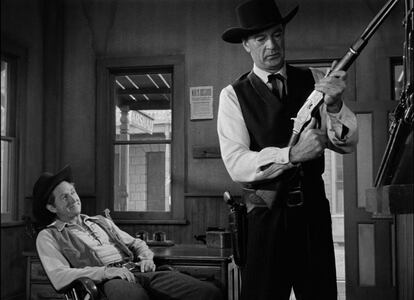
Nobody has explained the legacy of the Western in American culture better than the critic Robert Warshow. In a famous 1954 essay, The Westerner, he lays out why this genre has succeeded in capturing the hearts and minds of cinema-goers. “Values are compressed into the image of a lone man wearing a pistol on his belt. This tells us he lives in a violent world and he believes in it. Violence must come at the right time and with special rules, otherwise it holds no virtue,” Warshow wrote. This hero of the Wild West, above all, is concerned about preserving “the purity of his image,” and doesn’t fight for what is right, but to express himself. “The Westerner is the last gentleman, and the movies which over and over again tell his story are probably the last art form in which the concept of honor retains its strength.”
For a century, pistols have absorbed the values that the Western projects. A few weeks ago, Italian photographer Gabriele Galimberti published The Ameriguns, a project that took him to the homes of various gun fanatics in the US over the course of 18 months. During that time, he traveled across several regions of a nation that has more guns than it does inhabitants. Half of the world’s total private armory is held in the United States: 393 million weapons for 330 million people. Galimberti’s portraits are very effective in illustrating this statistic. “I met a family in Texas who had 216 guns. I recall the value of this arsenal was greater than the cost of the house that contained them. How is it possible that you spend more on guns than you do on the house in which you live?” he asks via telephone.
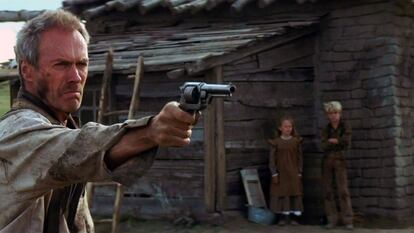
In Galimberti’s interviews, the words “family” and “freedom” are frequently repeated, regardless of whether it was a couple from rural Kansas or a gay technology executive from San Francisco who were talking. “They tend to say that the guns are to defend their freedom and are almost always linked to the family,” says the photographer. Many describe an initiation rite that starts when they are six or seven years old, when they fire a weapon for the first time under the guidance of their father or an uncle, in an outdoor pursuit that speaks to the mastery of nature. “That is usually exciting enough that it convinces them to go out and buy their first gun,” explains Galimberti.
The golden age of the Western
Hollywood has reinforced this culture. The golden age of the Western, with its value system, witnessed its twilight in the 1970s when the antiheroes seduced the public under the hand of the New Hollywood. Cultural critic Peter Biskind wrote in his 2018 book The Sky is Falling that Clint Eastwood helped to erode the code of honor of the man of the Wild West. Eastwood, a supporter of the US Republican party, tells an anecdote in which the director Don Siegel asked actor John Wayne to shoot a man in the back in a 1976 movie. Wayne, who embodied the moral compass of the genre, refused. “I don’t shoot people in the back,” the star of Stagecoach responded. “Clint Eastwood would,” Siegel replied. The big studios were becoming more and more conservative and the expansion of cable television, and much later streaming services, took advantage of the void to gamble on stories filled with violence, giving rise to characters such as Tony Soprano, Dexter and Walter White.
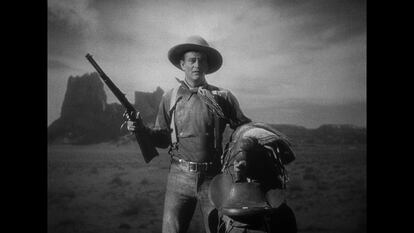
Siegel knew what he was talking about. He had directed Eastwood in Dirty Harry, which was a hit in 1971. The character, a tough detective who is hunting a serial killer in San Francisco, caused a furor with Eastwood’s Smith & Wesson .44 Magnum. The man who created Inspector Harry Callahan is movie-maker John Milius, who worked on the scripts for the first two movies in the Dirty Harry series. Milius, who also co-wrote Apocalypse Now with Francis Ford Coppola, was a member of the board of directors of the National Rifle Association (NRA), the powerful pro-firearms lobbying group that is currently at its lowest ebb.
Milius is described as a “Zen anarchist with libertarian and Republican tendencies” by the journalist Frank Smyth, author of The NRA, The Unauthorized Story. One of Milius’s movies, Red Dawn, was among the favorites of Timothy McVeigh, who was responsible for the 1995 Oklahoma City bombing that killed 168 people, including 19 children, and injured 680 more. Red Dawn is based on the recurring nightmare of the US right during the 1980s: a Communist invasion by the Soviet Union and its Cuban and Nicaraguan allies, who sweep through a small town in Colorado disarming its populace house to house. In 2012, a remake of Red Dawn starring Chris Hemsworth was released in which the invaders were North Korean. Milius proved decisive in an internal struggle for control at the head of the NRA, allying himself with Wayne LaPierre, the organization’s president. When the NRA took note of Hollywood’s power, it promoted the ascension of Charlton Heston, the star of classics such as The Ten Commandments and Ben-Hur, who was installed as president in 1998.
Will Hollywood witness any change after the tragedy on the set of Rust? Months before Hutchins’ death, former Arizona House of Representatives member Gabby Giffords, who became an advocate for gun control after surviving an assassination attempt in 2011, asked movie-makers to give firearms regulation a voice in their stories. “Few industries play a larger role in shaping culture than the entertainment industry,” she told Variety magazine in January.
Tu suscripción se está usando en otro dispositivo
¿Quieres añadir otro usuario a tu suscripción?
Si continúas leyendo en este dispositivo, no se podrá leer en el otro.
FlechaTu suscripción se está usando en otro dispositivo y solo puedes acceder a EL PAÍS desde un dispositivo a la vez.
Si quieres compartir tu cuenta, cambia tu suscripción a la modalidad Premium, así podrás añadir otro usuario. Cada uno accederá con su propia cuenta de email, lo que os permitirá personalizar vuestra experiencia en EL PAÍS.
¿Tienes una suscripción de empresa? Accede aquí para contratar más cuentas.
En el caso de no saber quién está usando tu cuenta, te recomendamos cambiar tu contraseña aquí.
Si decides continuar compartiendo tu cuenta, este mensaje se mostrará en tu dispositivo y en el de la otra persona que está usando tu cuenta de forma indefinida, afectando a tu experiencia de lectura. Puedes consultar aquí los términos y condiciones de la suscripción digital.
More information
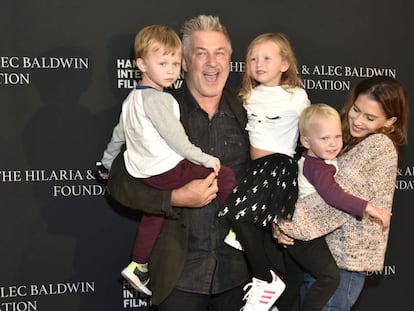
Alec Baldwin, an actor dogged by scandal
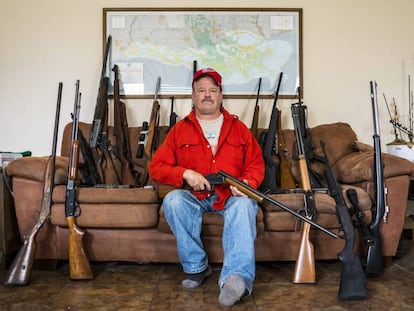
America’s gun arsenal
Archived In
Últimas noticias
Most viewed
- Reinhard Genzel, Nobel laureate in physics: ‘One-minute videos will never give you the truth’
- Oona Chaplin: ‘I told James Cameron that I was living in a treehouse and starting a permaculture project with a friend’
- Pablo Escobar’s hippos: A serious environmental problem, 40 years on
- Why we lost the habit of sleeping in two segments and how that changed our sense of time
- Chevy Chase, the beloved comedian who was a monster off camera: ‘Not everyone hated him, just the people who’ve worked with him’








































